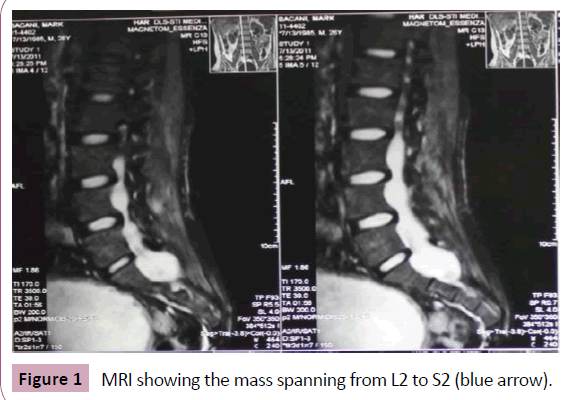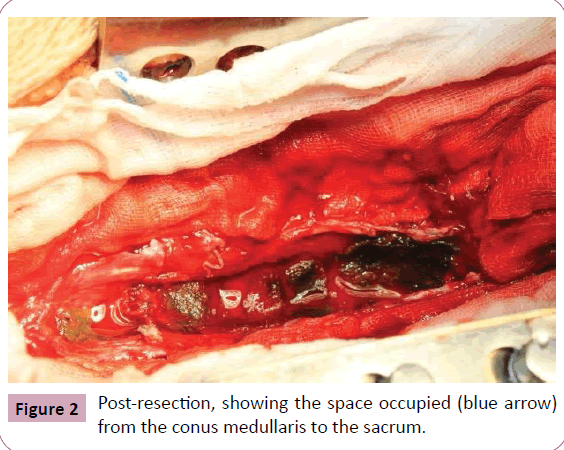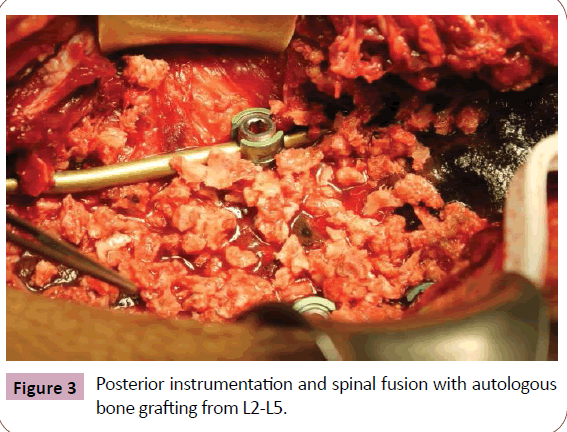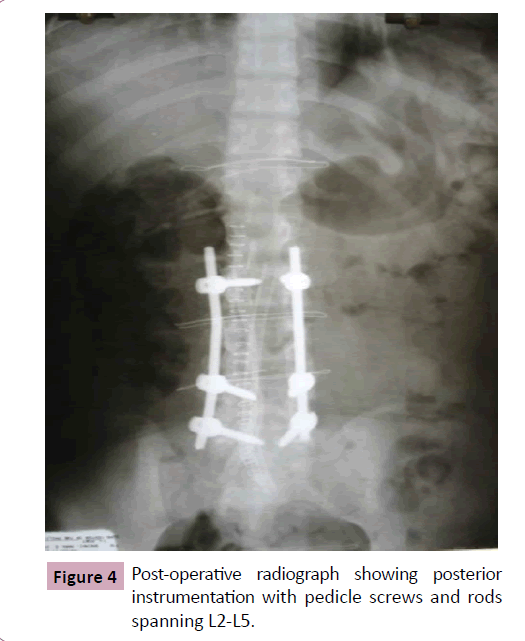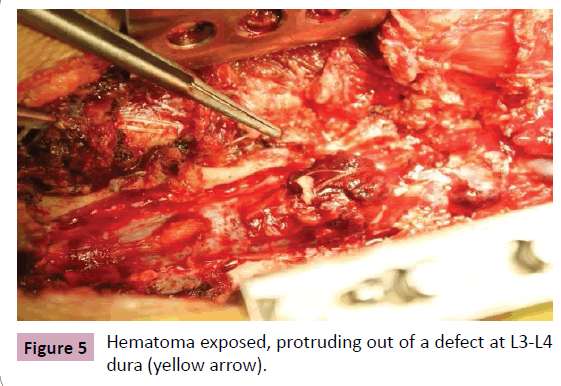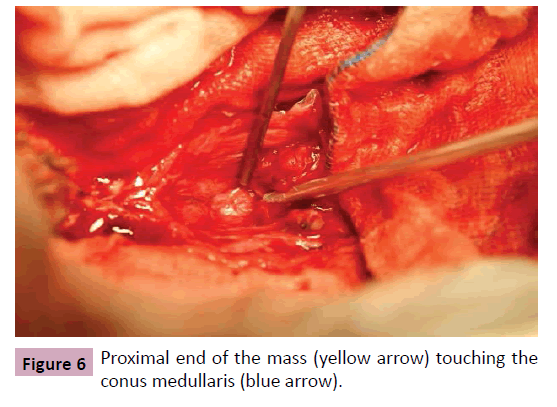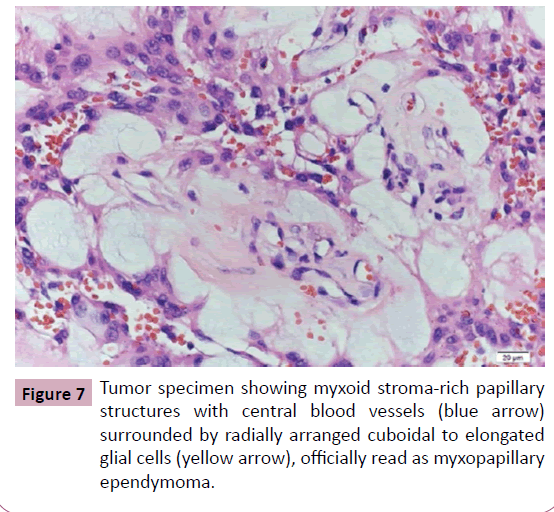Keywords
Spinal cord tumor; Intraspinal hematoma; Intradural ependymoma; Lumbar puncture
Introduction
Intradural spinal cord tumors are uncommon with an incidence of about 3-10 per 100,000 individuals. These tumors occur predominately in the third and fourth decades of life [1]. Ependymomas, a subset of intradural spinal cord tumors, are the most common gliomas of the lower cord, conus and filum terminale, and approximately 40% of all spinal ependymomas arise within the proximal intradural filum terminale [2]. Back pain is the most common presenting symptom, with neurological compromise rare secondary to the adaptive compressibility of the surrounding structures. Mork and Loken report that in 82% of patients with spinal ependymoma, symptoms were present for more than 1 year before the diagnosis was achieved [3].
Spinal ependymomas can originate from either the ependymal lining of the central canal of the spinal cord, ependymal cell clusters in the terminal filum, or from ependymal rests left during embryonic development [3,4]. In the lumbosacral region, the majority of ependymomas arise from the intradural terminal filum. These are characteristically well-encapsulated, sausageshaped tumors with the nerve roots of the cauda equina draped over the surface of the lesion or enveloped by it. Myxopapillary ependymomas comprise the majority of ependymomas that arise in this area, but papillary and cellular histiotypes can also occur here [3,5-10].
Intradural lumbosacral ependymomas can spread throughout the central nervous system but rarely metastasize beyond it [11], whereas extradural ependymomas seldom disseminate within the central nervous system but pose a significant risk for systemic metastases [11-15]. This observation can possibly explain intradural lumbosacral ependymomas enlarging to span multiple levels. However, multiple reports concerning intraspinal hematomas with neurological deterioration following spinal needle insertion exists [16]. A bleeding diathesis could be identified in approximately 70% of these cases, but other reports confirm intraspinal hemorrhages from a previously undiagnosed lumbar ependymoma after attempted spinal anesthesia [16-20]. An intraspinal hemorrhage of such cause can lead to intradural tumor seeding, which could consequently enlarge a previously small intradural tumor.
We present a case of a twenty-two year old male with a twoyear history of progressive low back pain that was complicated by bilateral lower extremity weakness and numbness, allegedly right after the time when the patient had unsuccessful lumbar punctures for a urologic procedure under spinal anesthesia. MRI findings suggested an intradural tumor spanning the length from the L2 to the S2 levels, which was confirmed intraoperatively with the mass seen affecting the conus medullaris and extending down to the sacrum. Specimen of the tumor excised was officially read as myxopapillary ependymoma.
Case Presentation
This is the case of a twenty-two year old male who presented with a two-year history of non-radiating low back pain that was later complicated, at 1 year prior to admission, by bilateral lower extremity weakness and numbness, progressing at 6 months prior to admission, to bladder and bowel incontinence and inability to ambulate. The patient allegedly had multiple unsuccessful lumbar punctures for a urologic procedure under spinal anesthesia at a local hospital a year prior to admission, just before the onset of bilateral lower extremity weakness and numbness. Also, at 1 year prior to admission, patient was allegedly started on morphine, the dose having been increased to 270 mg per shot at 6 months prior to admission, with poor pain control. Cough, fever, and other constitutional symptoms were not present, and the family, personal and social histories were unremarkable. Physical findings showed an alert, wheel-chair borne patient with stable vital signs and essentially normal systemic signs except for the obvious atrophy from the thighs down, bilaterally, and lumbar tenderness. Muscle strength was 3/5 bilaterally for the L2-S1 myotomes, and there was note of 50% sensory deficit on the L2 dermatome down, bilaterally. There was hyperreflexia on bilateral deep tendon reflex testing, and Babinski sign was positive bilaterally. There was also loss of perianal sensation, and an ankle clonus was elicited on the right, grade 3+.
Blood laboratory results and radiographs were unremarkable, but a contrast-enhanced multiplanar MRI examination of the lumbosacral spine demonstrated a large, nodular tumor mass lesion in the intraspinal intradural region noted from the L2 to S2 levels, with slight neural foraminal encroachment (Figure 1). In consideration of the size, meningioma was thought of as the primary differential, with ependymoma a likely second. Posterior decompression, intradural tumor resection, and posterior instrumentation with spinal fusion from L2-L5 were carried out (Figures 2-4). A large, dark-brownish tumor abutting the conus medullaris up to the S2 level was completely resected from a backdrop of intradural hemorrhage and blood clots, with dural tears noted over the L3-L4 and L4-L5 interspaces (Figures 5 and 6). Histomorphologic study of the tumor specimen showed myxoid stroma-rich papillary structures with central blood vessels surrounded by radially arranged cuboidal to elongated glial cells (Figure 7), and was officially read as myxopapillary ependymoma (WHO Grade 1).
Figure 1 MRI showing the mass spanning from L2 to S2 (blue arrow).
Figure 2 Post-resection, showing the space occupied (blue arrow) from the conus medullaris to the sacrum.
Figure 3 Posterior instrumentation and spinal fusion with autologous bone grafting from L2-L5.
Figure 4 Post-operative radiograph showing posterior instrumentation with pedicle screws and rods spanning L2-L5.
Figure 5 Hematoma exposed, protruding out of a defect at L3-L4 dura (yellow arrow).
Figure 6 Proximal end of the mass (yellow arrow) touching the conus medullaris (blue arrow).
Figure 7 Tumor specimen showing myxoid stroma-rich papillary structures with central blood vessels (blue arrow) surrounded by radially arranged cuboidal to elongated glial cells (yellow arrow), officially read as myxopapillary ependymoma.
The patient’s post-operative course is unremarkable, with the hip flexors and knee extensors improving to 4/5 bilaterally by the second week, the ankle dorsiflexors and big toe extensors to 4/5 bilaterally by the third week, and the ankle plantarflexors to 4/5 bilaterally by the fourth week. At 1 month post-operation, the patient is able to ambulate with a walker. The ankle clonus on the right has disappeared by the second week, and dermatomal, including perianal sensation has been fully regained bilaterally by the fourth week. There are yet no signs of bladder and bowel recovery. Tapering down of morphine was started at 1 week postoperation, and the patient was completely weaned by the second week.
Discussion
In 1946, Nicholson et al. [21] mentioned the possible neurological complications of spinal anesthesia in the presence of previously undiagnosed spinal space?occupying tumors. The authors considered the neurological complications mainly attributable to the occurrence of neurotoxic effects caused by the injected anesthetic agent which could not be diluted appropriately, due to impaired flow of cerebrospinal fluid caused by the lesion. Furthermore, the risk of neurological deterioration following lumbar puncture below a spinal subarachnoid block has been shown to be at least as high as 14% [22]. In these cases, the mechanism of ‘spinal coning’ through exacerbation of pressure differentials above and below the block following removal of cerebrospinal fluid has been suggested.
The first report of neurological complications in connection with iatrogenic hemorrhage from a spinal neoplasm was by Roscoe et al. in 1984 [17]. They reported a 24 year?old parturient, who, 3 days after uneventful epidural analgesia at the L2?3 interspace, developed increasing low back pain and bladder dysfunction, together with gradual worsening of motor and sensory function in both legs. In the emergent decompressive laminectomy 17 hrs after the onset of neurological symptoms, dural perforation of the distended thecal sac was found and an ependymoma with intratumoral hemorrhage was excised. The patient made an almost complete recovery with intact bladder function and ability to walk with leg brace support.
Since then, three additional cases of similar pathology have been described. Bredtmann et al. [18] reported hemorrhage from a tumor in a 58 year?old male following uneventful subarachnoid injection of the anesthetic agent after clear cerebrospinal fluid was obtained at the L3?4 level. Starting 6 hrs later, the patient developed severe low back pain, headaches, and meningism. Laminectomy was performed 3 days after onset of symptoms and an ependymoma at L3?4, together with an intradural blood clot, was removed. The patient recovered completely.
In a 79 year?old female, several attempts of epidural anesthesia were performed in vain at the L2?3 and L3?4 interspaces [19]. The epidural space could not be located precisely. It was then decided to perform general anesthesia. Over the next 3 weeks the patient experienced the development of almost complete paraplegia.
In the subsequent laminectomy, an ependymoma with massive intratumoral hemorrhage was removed and the patient made a satisfactory recovery of motor and autonomic function. In the last two reports described, both patients retrospectively complained of a history of increasing radicular pain in both legs preoperatively, but these symptoms were not appropriately diagnosed by the responsible physicians.
Jaeger et al. [20] reported intradural blood clots evacuated together with an ependymoma in a laminotomy procedure after an unsuccessful attempt at spinal anesthesia at the L1-L2 level was carried out in a 28 year-old parturient. Approximately 12 hrs post-Caesarian section, the patient started to complain of mild paresthesia in both feet and calves, and over the next 12 hrs she presented with complete paraplegia and anesthesia from L1, including urinary retention and absent anal sphincter tone. MRI showed extended intraspinal bleeding from T12 to L2, and neuropathological examination revealed an ependymoma with massive intratumoral hemorrhage. Bowel, but not bladder function, has been regained at eight months post-resection, with motor function slowly improving to being able to walk about 5 m with crutches.
Reviewing these reports of neurological malfunction following puncture into an undiagnosed lumbar tumor and subsequent hemorrhage, we found that in all five cases (including the one presented in this paper), the hemorrhage arose from an ependymoma. These intradural neoplasms of the cauda equina and conal region are thought to be prone to hemorrhage due to their vascular structure [23] and are known to present with spontaneous bleeding [24]. Despite the intradural location of ependymomas, the hazards of iatrogenic hemorrhage do not solely occur after spinal anesthesia; they occur also after epidural anesthesia. The thecal sac distended by the tumor, together with a compressed epidural space, is likely to be punctured with subsequent injury of the underlying fragile tumor vessels. Iatrogenic hemorrhage can facilitate tumor seeding to nearby cord levels leading to massive tumor enlargement, and it serves our primary hypothesis in explaining why the tumor we resected has the length as described.
It is fortunate that with the posterior decompression, intradural tumor resection, posterior instrumentation and spinal fusion done a year after the onset of neurologic deterioration following the alleged unsuccessful lumbar punctures that have caused intraspinal hemorrhage in our case, the post-operative neurologic status seems to be improving well. This neurologic course appears similar to that of the reports we have reviewed, but we deem it prudent to come up with a follow-study of the patient’s course ten years from now. To incautiously suggest a good prognosis and excellent neurologic outcomes for our case, which involved a delayed surgical intervention, is premature to tell. However, a tailored rehabilitation program shall be started to facilitate neurologic recovery.
This report draws attention to the need for careful evaluation of symptoms suggesting the presence of a spinal mass, before lumbar puncture, peridural, or spinal anesthesia is planned. In patients complaining of a history of increasing low back pain, bladder dysfunction, weakness, or paresthesias of the lower limbs, Jaeger et al. [20] strongly recommended postponing the procedure. In an emergency situation, however, they added that spinal anesthesia should not be attempted and general anesthesia should be undertaken.
Postprocedural observation always needs to rule out signs of increasing lumbar root compression. Interestingly, in all cases described, the onset of neurological deterioration was not immediately after the lumbar puncture. First symptoms occurred 6 hrs after the operation at the earliest and 3 days at the latest. Jaeger et al. [20] suggested that if spinal bleeding is suspected, a MRI of the lumbar and lower thoracic spine is considered the appropriate diagnostic tool.
We recommend that prompt surgical evacuation of a symptomatic lumbar hematoma resulting from tumoral bleeding should always be attempted. Even in the presence of severe neurological dysfunction for hours and even weeks, all patients made at least a partial recovery, resulting in significantly diminished morbidity [24]. As with our case, even in the presence of severe neurological dysfunction for a year, our patient appears to make a good recovery.
References
- Stein BM, McCormick PC (1996) Spinal intradural tumors. In Wilkins RH, Rengachary SS, eds. Neurosurgery, New York, McGraw-Hill. 2: 1769-1781.
- Kuntz C, Shaffrey CI, Wolcott WP (2004) Approach to the Patient and Medical Management of Spinal Disorders. In: Winn HR, (Ed)Youmans Neurological Surgery, Philadelphia, Saunders 4: 4289-4326.
- Mork SJ, Loken AC (1977) Ependymoma: a follow-up study of 101 cases. Cancer 40: 907-915.
- Chamberlain MC1 (2002) Salvage chemotherapy for recurrent spinal cord ependymona.Cancer 95: 997-1002.
- Bavbek M, Altinörs MN, Caner HH, Bilezikçi B, Agildere M (2001) Lumbar myxopapillaryependymoma mimicking neurofibroma.Spinal Cord 39: 449-452.
- Burtscher J, Felber S, Twerdy K, Langmayr JJ (2002) Endoscope-assisted interlaminar removal of an ependymoma of the caudaequina.Minim Invasive Neurosurg 45: 41-44.
- Celli P, Cervoni L, Cantore G (1993) Ependymoma of the filumterminale: treatment and prognostic factors in a series of 28 cases.ActaNeurochir (Wien) 124: 99-103.
- Davis C, Barnard RO (1985) Malignant behavior of myxopapillaryependymoma. Report of three cases.J Neurosurg 62: 925-929.
- Fourney DR, Fuller GN, Gokaslan ZL (2000)Intraspinal extradural myxopapillaryependymoma of the sacrum arising from the filumterminaleexterna. Case report. J Neurosurg (Spine 2) 93: 322–326.
- Hallacq P, Labrousse F, Streichenberger N, Lisii D, Fischer G (2003) Bifocal myxopapillaryependymoma of the terminal filum: the end of a spectrum? Case report.J Neurosurg 98: 288-289.
- Fassett DR, Schmidt MH (2003) Lumbosacral ependymomas: a review of the management of intradural and extradural tumors.Neurosurg Focus 15: E13.
- Timmerman W, Bubrick MP (1984) Presacral and postsacralextraspinalependymoma. Report of a case and review of the literature.Dis Colon Rectum 27: 114-119.
- Vagaiwala MR, Robinson JS, Galicich JH, Gralla RJ, Helson L, et al. (1979) Metastasizing extradural ependymoma of the sacrococcygeal region: case report and review of literature.Cancer 44: 326-333.
- Thornton AS, Yudelman P (1988) Anteriorextrathecalependymoma with systemic metastases--a case report and review of the literature.ClinRadiol 39: 562-564.
- Helwig EB, Stern JB (1984) Subcutaneoussacrococcygealmyxopapillaryependymoma. A clinicopathologic study of 32 cases.Am J ClinPathol 81: 156-161.
- Sage DJ (1990) Epidurals, spinals and bleeding disorders in pregnancy: a review.Anaesth Intensive Care 18: 319-326.
- Roscoe MW, Barrington TW (1984) Acute spinal subdural hematoma. A case report and review of literature.Spine (Phila Pa 1976) 9: 672-675.
- Bredtmann RD, Wright J, Weissflog M (1989) [A space-occupying hemorrhage following spinal anesthesia in the presence of an undiagnosed small spinal tumor (ependymoma)].RegAnaesth 12: 38-40.
- Antoniadis G, Richter HP, Schachenmayr W (1985) Hemorrhage into a spinal ependymoma after peridural anesthesia.Neurosurgery 16: 669-671.
- Jaeger M, Rickels E, Schmidt A, Samii M, Blömer U (2002) Lumbar ependymoma presenting with paraplegia following attempted spinal anaesthesia.Br J Anaesth 88: 438-440.
- Nicholson MJ, Eversole UH (1946) Neurologic complications of spinal anesthesia.J Am Med Assoc 132: 679-685.
- Hollis PH, Malis LI, Zappulla RA (1986) Neurological deterioration after lumbar puncture below complete spinal subarachnoid block. J Neurosurg 64: 253–256.
- Russell DS, Rubenstein LJ (1977) Pathology of Tumours of the Nervous System. Baltimore, Williams & Wilkins, 115–123.
- Lagares A, Rivas JJ, Lobato RD, Ramos A, Alday R, et al. (2000) Spinal cord ependymoma presenting with acute paraplegia due to tumoral bleeding.J NeurosurgSci 44: 95-97.

